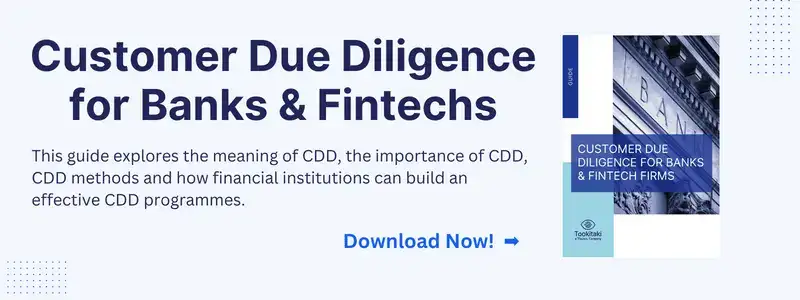Enhanced Due Diligence (EDD): Managing Risk and Compliance
What is Enhanced Due Diligence (EDD)?
Enhanced Due Diligence (EDD) refers to the comprehensive process of gathering and analyzing additional information about customers or business entities that pose higher risk levels. The primary purpose of EDD is to obtain a deeper understanding of the customer's background, business operations, sources of funds, and potential risk factors.
By conducting EDD, organizations aim to enhance risk assessment, strengthen compliance with anti-money laundering (AML) and counter-terrorism financing (CTF) regulations, and mitigate the potential risks associated with high-risk customers.
As financial crimes and illicit activities continue to evolve, organizations need to adopt more stringent measures to identify and mitigate potential risks. EDD goes beyond standard due diligence procedures to provide a deeper understanding of customers, transactions, and relationships. EDD is essential for identifying potential involvement in activities like insider trading, terrorist financing, or money laundering.
In this article, we delve into the concept of Enhanced Due Diligence, its triggers, the distinction from Customer Due Diligence (CDD), and its requirements. We will also explore practical examples, checklists, and scenarios in which EDD is necessary for high-risk customers.
Key Takeaways
- Enhanced Due Diligence (EDD) is an advanced level of customer due diligence that focuses on high-risk customers and transactions.
- EDD is triggered by factors such as high-risk customer profiles, unusual transactions, politically exposed persons (PEPs), or dealings with sanctioned entities.
- EDD goes beyond the basic identity verification and risk assessment of Customer Due Diligence (CDD) and involves gathering additional information, conducting in-depth analysis, and implementing stringent monitoring processes.
- The EDD process includes obtaining detailed customer information, verifying the source of funds, assessing beneficial ownership, and analyzing risk indicators.
- EDD practices may involve background checks, on-site visits, interviews, and continuous monitoring of high-risk customers.
Why is EDD Required?
The following are the reasons why a financial institution should have defined Enhanced Due Diligence procedures:
- Ensuring Regulatory Compliance: EDD procedures ensure that a financial institution is in compliance with applicable AML/KYC laws and regulations. By being compliant, financial institutions can avoid hefty fines and other punitive actions.
- Better Customer Service: As a by-product of EDD procedures, financial institutions get access to a vast amount of information about their customers such as employment status, age and income levels. This will help financial institutions tailor their products and services to specific customer needs and serve them better.
- Brand Reputation: Proper EDD procedures help financial institutions protect their platforms from abuse by criminals. By safeguarding against money laundering and terrorist financing with proper controls, financial institutions become trustworthy in front of the public, leading to enhanced reputation.
- Financial Crime Prevention: Thorough checks on a customer’s identity, transactions and related information would help identify possible fraudulent and criminal activities well in advance.
Triggers for Enhanced Due Diligence (EDD)
Various triggers can prompt the implementation of Enhanced Due Diligence measures. These triggers include:
- High-Risk Customers: Customers are categorized as high-risk due to factors such as their occupation, country of residence, or previous involvement in suspicious activities.
- Unusual Transactions: Transactions that deviate from the customer's normal behaviour or exhibit red flags, such as large cash transactions, frequent international transfers, or complex structures.
- Politically Exposed Persons (PEPs): Individuals who hold prominent public positions or have close associations with government officials may increase the risk of corruption or illicit financial activities.
- Sanctioned Entities: Entities or individuals listed on national or international sanction lists, indicating their involvement in illegal activities or associations with prohibited regimes.
Checklist for Enhanced Due Diligence
According to the Financial Action Task Force (FATF), financial institutions should employ a risk-based approach when they try to assess their customers for possible ties to money laundering and terrorist financing (ML/TF) activities. “Customer due diligence (CDD) processes should be designed to help banks understand who their customers are by requiring them to gather information on what they do and why they require banking services,” says the FATF.
The watchdog adds that enhanced monitoring should be required for higher-risk situations, while banks may decide to reduce the frequency and intensity of monitoring where the risks are lower. The amount and type of information obtained, and the extent to which this information is verified, must be increased in high-risk cases. It may also be simplified where the risk associated with the business relationship is lower.
The FATF has suggested banks “to draw up, and periodically update, customer risk profiles, which serve to help banks apply the appropriate level of CDD”.
It has recommended the following as practicable Enhanced Due Diligence procedures:
- Obtaining additional identifying information from a wider variety or more robust sources and using the information to inform the individual customer risk assessment
- Carrying out additional searches (for example, verifiable adverse media searches) to inform the individual customer risk assessment
- Commissioning an intelligence report on the customer or beneficial owner to understand the risk that the customer or beneficial owner may be involved in criminal activity
- Verifying the source of funds or wealth involved in the business relationship to be satisfied that they do not constitute the proceeds from crime
- Seeking additional information from the customer about the purpose and intended nature of the business relationship
Process for Enhanced Due Diligence (EDD)
Gathering Additional Information
EDD requires organizations to gather a wide range of additional information about high-risk customers. This includes:
- Business Details: In the case of corporate customers, obtaining comprehensive information about their ownership structure, key stakeholders, and business activities.
- Source of Funds: Understanding the legitimate sources of a customer's wealth and funds, ensuring they are not derived from illicit activities.
- Beneficial Ownership: Identifying the individuals who ultimately own or control the customer entity to mitigate risks associated with hidden ownership.
- Risk Indicators: Analyzing various risk factors specific to the customer, such as their geographic location, industry, transaction patterns, and previous regulatory or legal issues.
- Enhanced Identity Verification: Implementing more robust identity verification processes, including additional documentation and verification methods.
Enhanced Due Diligence can take different forms depending on the nature of the customer or transaction. Some examples include:
- In-Depth Background Checks: Conducting comprehensive background checks on key individuals associated with the customer, including their professional history, reputation, and any criminal records.
- Third-Party Data Analysis: Utilizing third-party data providers or risk intelligence platforms to gather additional insights and assess the customer's risk level.
- On-Site Visits and Interviews: In certain cases, organizations may conduct on-site visits to a customer's business premises or arrange face-to-face interviews to validate information and assess the overall risk environment.
- Continuous Monitoring: Implementing ongoing monitoring processes to detect any unusual or suspicious activities associated with high-risk customers, such as monitoring transactions, media coverage, or regulatory changes.
What is the difference between KYC, CDD and EDD?
KYC, CDD and EDD are related AML processes that help financial institutions make sure their customers do not pose any AML risk. KYC is carried out by financial institutions when customers open new accounts. Financial institutions have a KYC risk rating system which rates their customers based on obtained details.
CDD is a part within KYC and involves background checks to assess the AML risk of customers before onboarding them.
EDD is a form of CDD which is carried out on high-risk customers and involves matching their names with various watchlists. In contrast, there are Standard Customer Due Diligence and Simplified Due Diligence which are more lenient versions of Customer Due Diligence.
Scenarios Requiring Enhanced Due Diligence (EDD)
High-Risk Industries
Certain industries are inherently more susceptible to financial crimes or illicit activities, necessitating the implementation of Enhanced Due Diligence measures. These industries may include:
- Money Services Businesses (MSBs): Due to the potential for money laundering and terrorist financing activities.
- Casino and Gaming: To prevent illegal funds from being laundered through gambling activities.
- Cryptocurrency Exchanges: Given cryptocurrency transactions' anonymity and global nature, EDD helps mitigate the risks associated with digital currencies.
- Correspondent Banking: A high-risk area where financial institutions establish relationships with foreign banks, requiring thorough EDD to prevent money laundering and terrorist financing.
High-Risk Customer Categories
Certain customer categories are inherently higher risk, triggering the need for Enhanced Due Diligence. These categories may include:
- Politically Exposed Persons (PEPs): Individuals holding prominent public positions who may have greater potential for corruption or involvement in illicit activities.
- High-Net-Worth Individuals (HNWIs): Individuals with substantial wealth, as their financial activities, may attract undue attention or be vulnerable to exploitation.
- Non-Resident Customers: Customers residing in jurisdictions known for weak AML/CFT frameworks or higher risks of financial crimes.
- Complex Business Structures: Customers with complex ownership structures or offshore entities that require thorough investigation to determine the ultimate beneficial owners and mitigate potential risks.
How Can Tookitaki Enhance EDD?
Enhanced Due Diligence (EDD) is crucial in mitigating risks, ensuring compliance, and protecting businesses from financial crimes. By going beyond standard Customer Due Dilligence (CDD) procedures, EDD provides organizations with a deeper understanding of high-risk customers and transactions. By gathering additional information, analysing risk indicators, and implementing stringent monitoring processes, EDD enables businesses to identify and mitigate potential risks more effectively.
Today, modern technologies like AI and machine learning are getting widespread attention for their ability to improve business processes and regulators are encouraging financial institutions including fintech companies to adopt innovative approaches to combat money laundering. In the area of customer due diligence and risk scoring, the need of the hour is a sophisticated technology that can capture the complete customer activity through proper identification of risk indicators and continuously update customer profiles as underlying activities change.
Keeping that in mind, Tookitaki developed its FinCense solution. Powered by advanced machine learning, the solution addresses the market needs and helps build effective and scalable fraud and AML compliance programmes, encompassing screening, transaction monitoring and customer risk scoring. To know more about our solution, book a meeting with one of our experts.
Anti-Financial Crime Compliance with Tookitaki?
Related Terms
Recent Posts


.png?width=250&height=104&name=PNG%20-%20Montserrat%20LOGO%20-%20a%20Thunes%20company%20(White).png)
-1.png?width=200&height=83&name=PNG%20-%20Montserrat%20LOGO%20-%20a%20Thunes%20company%20(White)-1.png)




